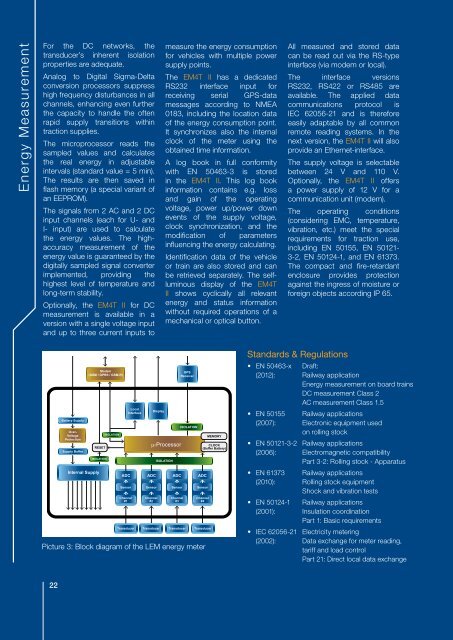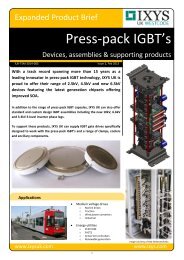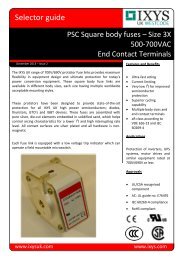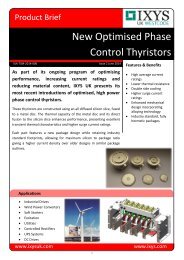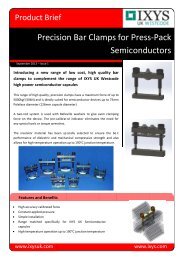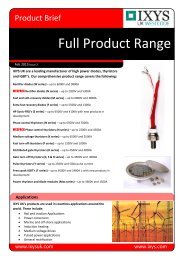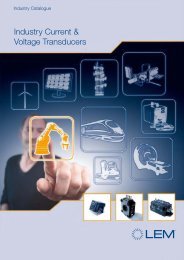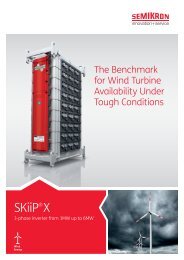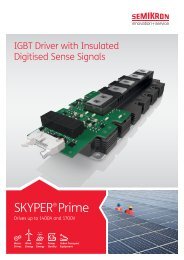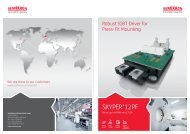railway current voltage transducers
Create successful ePaper yourself
Turn your PDF publications into a flip-book with our unique Google optimized e-Paper software.
Energy Measurement<br />
For the DC networks, the<br />
transducer’s inherent isolation<br />
properties are adequate.<br />
Analog to Digital Sigma-Delta<br />
conversion processors suppress<br />
high frequency disturbances in all<br />
channels, enhancing even further<br />
the capacity to handle the often<br />
rapid supply transitions within<br />
traction supplies.<br />
The microprocessor reads the<br />
sampled values and calculates<br />
the real energy in adjustable<br />
intervals (standard value = 5 min).<br />
The results are then saved in<br />
flash memory (a special variant of<br />
an EEPROM).<br />
The signals from 2 AC and 2 DC<br />
input channels (each for U- and<br />
I- input) are used to calculate<br />
the energy values. The highaccuracy<br />
measurement of the<br />
energy value is guaranteed by the<br />
digitally sampled signal converter<br />
implemented, providing the<br />
highest level of temperature and<br />
long-term stability.<br />
Optionally, the EM4T II for DC<br />
measurement is available in a<br />
version with a single <strong>voltage</strong> input<br />
and up to three <strong>current</strong> inputs to<br />
Battery Supply<br />
Over-<br />
Voltage<br />
Protection<br />
Supply Buffer<br />
Modem<br />
(GSM / GPRS / GSM-R)<br />
RESET<br />
ISOLATION<br />
ISOLATION<br />
Local<br />
Interface<br />
Display<br />
measure the energy consumption<br />
for vehicles with multiple power<br />
supply points.<br />
The EM4T II has a dedicated<br />
RS232 interface input for<br />
receiving serial GPS-data<br />
messages according to NMEA<br />
0183, including the location data<br />
of the energy consumption point.<br />
It synchronizes also the internal<br />
clock of the meter using the<br />
obtained time information.<br />
A log book in full conformity<br />
with EN 50463-3 is stored<br />
in the EM4T II. This log book<br />
information contains e.g. loss<br />
and gain of the operating<br />
<strong>voltage</strong>, power up/power down<br />
events of the supply <strong>voltage</strong>,<br />
clock synchronization, and the<br />
modification of parameters<br />
influencing the energy calculating.<br />
Identification data of the vehicle<br />
or train are also stored and can<br />
be retrieved separately. The selfluminous<br />
display of the EM4T<br />
II shows cyclically all relevant<br />
energy and status information<br />
without required operations of a<br />
mechanical or optical button.<br />
µ-Processor<br />
ISOLATION<br />
GPS<br />
Receiver<br />
ISOLATION<br />
MEMORY<br />
CLOCK<br />
(Buffer Battery)<br />
All measured and stored data<br />
can be read out via the RS-type<br />
interface (via modem or local).<br />
The interface versions<br />
RS232, RS422 or RS485 are<br />
available. The applied data<br />
communications protocol is<br />
IEC 62056-21 and is therefore<br />
easily adaptable by all common<br />
remote reading systems. In the<br />
next version, the EM4T II will also<br />
provide an Ethernet-interface.<br />
The supply <strong>voltage</strong> is selectable<br />
between 24 V and 110 V.<br />
Optionally, the EM4T II offers<br />
a power supply of 12 V for a<br />
communication unit (modem).<br />
The operating conditions<br />
(considering EMC, temperature,<br />
vibration, etc.) meet the special<br />
requirements for traction use,<br />
including EN 50155, EN 50121-<br />
3-2, EN 50124-1, and EN 61373.<br />
The compact and fire-retardant<br />
enclosure provides protection<br />
against the ingress of moisture or<br />
foreign objects according IP 65.<br />
Standards & Regulations<br />
• EN 50463-x Draft:<br />
(2012): Railway application<br />
Energy measurement on board trains<br />
DC measurement Class 2<br />
AC measurement Class 1.5<br />
• EN 50155 Railway applications<br />
(2007): Electronic equipment used<br />
on rolling stock<br />
• EN 50121-3-2 Railway applications<br />
(2006): Electromagnetic compatibility<br />
Part 3-2: Rolling stock - Apparatus<br />
ITC 4000-S<br />
EM4T II<br />
DI 30...200 mV<br />
(Shunt isolator)<br />
Class 1R<br />
High galvanic insulation<br />
DV 4200/SP4<br />
DV-VOLTAGE FAMILY<br />
1200 to 4200 V RMS<br />
One unique compact package<br />
Class 0.75R accuracy<br />
Low thermal drift<br />
DI<br />
ITC 2000-S<br />
Shunt<br />
Part of a high <strong>voltage</strong> frame of a multi-system locomotive with the positions needed for<br />
<strong>current</strong> & <strong>voltage</strong> measurement<br />
Energy Measurement<br />
Internal Supply<br />
ADC ADC ADC ADC<br />
Sensor<br />
Channel<br />
#1<br />
Sensor<br />
Channel<br />
#2<br />
Sensor<br />
Channel<br />
#3<br />
Sensor<br />
Channel<br />
#4<br />
Transducer Transducer Transducer Transducer<br />
Picture 3: Block diagram of the LEM energy meter<br />
• EN 61373 Railway applications<br />
(2010): Rolling stock equipment<br />
Shock and vibration tests<br />
• EN 50124-1 Railway applications<br />
(2001): Insulation coordination<br />
Part 1: Basic requirements<br />
• IEC 62056-21 Electricity metering<br />
(2002): Data exchange for meter reading,<br />
tariff and load control<br />
Part 21: Direct local data exchange<br />
ITC 2000...4000-S FAMILY<br />
Better than Class 0.5R<br />
High temperature stability<br />
22<br />
23


